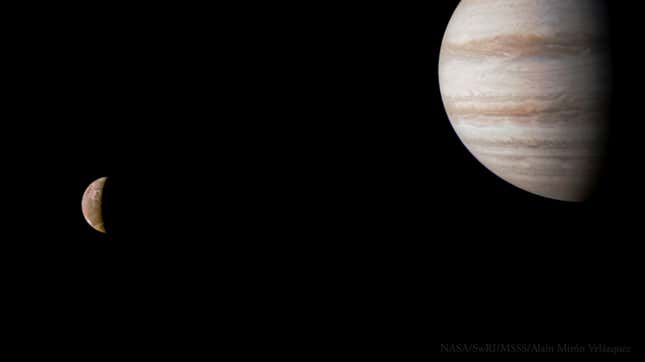
NASA’s Juno spacecraft has been orbiting Jupiter for more than seven years, capturing some of the most iconic images of the planet’s swirling winds and tumultuous storms. In the most recent image from the mission, however, the gas giant poses alongside another familiar object that’s also got a lot going on.
During its 53rd close flyby of Jupiter on July 31, Juno also caught a glimpse of its Jovian moon Io. The spacecraft was able to capture both Jupiter and its volcanic moon in an endearing family picture. This week, NASA released the captivating view of the two celestial bodies side by side.
Images captured by Juno are released to the public through the mission’s website, and oftentimes dedicated citizen scientists create the most beautiful results using the spacecraft’s raw data. For this image, citizen scientist Alain Mirón Velázquez processed a raw image from the JunoCam instrument, enhancing the contrast, color, and sharpness, according to NASA.
At the time the image was taken, Juno was around 32,170 miles (51,770 kilometers) away from Io and about 245,000 miles above Jupiter’s cloud tops (395,000 km). This is the closest the spacecraft has gotten to Io thus far, with closer encounters planned for later this year and in 2024.
During Juno’s upcoming close flyby of Io on December 30 and February 1, 2024, scientists from the Southwest Research Institute (SwRI) will use the Hubble and James Webb telescopes to simultaneously observe the Jovian moon from a distance.
As the innermost of Jupiter’s large moons, Io is wedged between Jupiter’s immense gravitational force, as well as the gravitational tug of its sister moons Europa and Ganymede. As a result, the moon is constantly being stretched and squeezed, which contributes to its volcanic activity. The Jovian moon is the most volcanically active body in the solar system, with hundreds of volcanoes and lakes of molten silicate lava on its surface.
For more spaceflight in your life, follow us on X (formerly Twitter) and bookmark Gizmodo’s dedicated Spaceflight page.